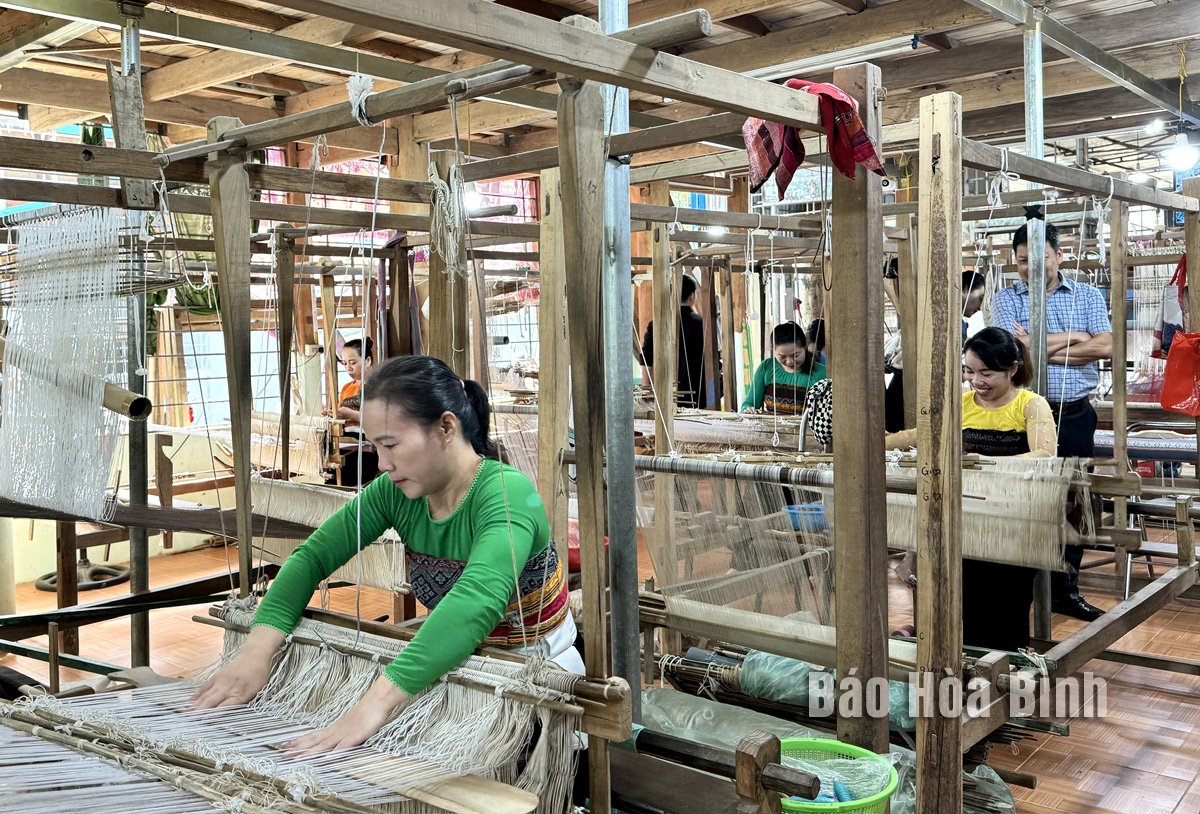
Established in 2013, Chieng Chau Brocade Weaving and Service Cooperative (Chieng Chau Commune, Mai Chau) now has 21 members and around 80 additional employees outside the cooperative working on orders. After overcoming many challenges, the cooperative has gradually asserted its position in the market, providing the stable jobs for many Thai ethnic women in the commune. Recently, with the dedication and determination, these Thai women have continuously innovated and worked hard to preserve their traditional craft, bringing culturally rich products to both domestic and international tourists.
Chieng Chau Brocade Weaving and Service Cooperative (Mai Chau) is committed to preserving the traditional weaving craft and producing the unique and diverse brocade products.
Being the youngest member of the cooperative, Ms. Mac Thi Thanh Mai from Chieng Chau hamlet, is proud to uphold her ethnic group's traditional craft while earning an income to support her life. She says that from a young age, her mother taught her both the techniques and the love for brocade weaving. Thus, when the cooperative was established, she eagerly joined as a member. In the past, most brocade products were made to meet the local demand. Now, with the hometown changing and more tourists visiting Mai Chau, the demand for brocade products as gifts has increased and diversified. At the cooperative, she finds the work she loves, which suits to her health, and she also can preserve her ethnic craft and secure a stable income.
To "keep the fire” of the craft alive and inspire other women to preserve and promote ethnic values through the traditional weaving, the cooperative has researched and diversified the brocade products by incorporating tailoring. Creating the products based on the heritage of the conventional brocade patterns, the cooperative continues to use the natural cotton fabrics and follows the traditional production methods from spinning, and dyeing, to weaving, which require the meticulous effort. Machinery only supports the final stages of product finishing. Previously, brocade was primarily used for blankets, scarves, pillows, and clothes. Today, the cooperative offers a wider range of products to meet the tourists’ demands, including modernized clothing for men and women, handbags, laptop bags, tablecloths, notebook covers, keychains, and home décor items.
To meet the customers’ needs, the cooperative ensures its product prices remain competitive while preserving the distinctive cultural features of Thai ethnic people. The cooperative invests in machinery, technology and labor to improve production efficiency. Currently, it has a workshop of over 300 square meters, 14 sewing machines, and about 50 weaving looms. All products are produced in a closed-loop process, from weaving to sewing and embroidery to the finished products.
In its efforts to expand its market, the cooperative has actively participated in product promotion at trade fairs and commercial programs. Over the years, the cooperative’s products have gradually established a stable market presence. Two of its brocade products have been recognized as OCOP 3-4 star products at the provincial level. In 2023, the cooperative achieved a revenue of over 3 billion VND.
Ms. Vi Thi Oanh, the Deputy Director of the cooperative, says that after 15 years of development, the cooperative's success is due to the support from the local authorities and organizations. With a stable income of 5 million VND per person each month or more, the members and employees have improved their incomes, overcome hardships, and stabilized their lives, while they can also preserve the traditional brocade weaving of their ethnic group. To expand production, the cooperative aims to open more workshops, produce more products, create jobs for women in the commune, and attract new members. However, the cooperative faces the challenges due to a lack of land for construction. Therefore, it hopes for the support from the local leaders and authorities to help the cooperative fulfill its role in collective economic development and the preservation of the traditional crafts.
As a land deeply intertwined with human history and Vietnam’s millennia-long journey of nation-building and defence, Hoa Binh is often revered for its epic tales and legends.
Residents of Hoa Binh boast a rich cultural identity, reflected in their unique language, traditional attire, customs, and folk melodies – described as "sweet as honey, clear as a mountain stream.”
Lac Son district’s Vu ban town held the 2025 Truong Kha temple festival on April 12–13 (the 15th–16th days of the third lunar month). Since its revival in 2019, the festival has been organised every three years, preserving valuable intangible heritage while meeting the community’s cultural and spiritual needs.
The clothing of women reflects the culture of the Muong, Thai, Tay, Dao, and Mong ethnic groups in the northern province of Hoa Binh.
Gongs hold a special place in the cultural and spiritual life of the Muong ethnic people in Hoa Binh province. More than musical instruments, they are an indispensable part of community rituals and collective memory, echoing through generations as a spiritual thread linking the past, present, and future.
Preserving and promoting the cultural values of the Muong ethnic group has become an urgent task in the current context, as many traditional values face the risk of fading away. This effort requires not only protecting the cultural identity but also eliminating outdated customs and developing a modern cultural lifestyle, contributing to sustainable values for the Muong community in Hoa Binh province.
The Muong ethnic culture, deeply rooted in Vietnam’s mountainous north, continues to be preserved and revitalised by dedicated individuals and communities determined to safeguard their ancestral identity.



